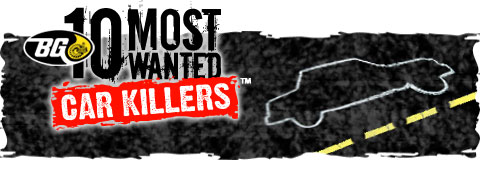10 Most Wanted Car Killers: Get to Know Your Car’s Worst Enemies
September 09, 2006

Beware of these 10 most wanted car killers, the corrosive agents of your car’s destruction from within.
- Lube & fuel oxidation
- Diesel injection clogging
- Drive line abrasion
- Fuel/air induction carbon
- Transmission sludge
- Power steering debris
- Cooling system scale
- Brake fluid moisture contamination
- Climate control mold
- Battery corrosion
They tend to be stealthy killers, often escaping the notice of even the most careful car owners. Thankfully there’s a way to protect your car with BG products and services.
Get to know your car’s 10 worst enemies.
1. Oil and fuel oxidation
Engine oil breaks down and produces killer sludge that can reduce engine cooling and accelerate component wear. Abrasive material then accumulates within the engine, which can destroy bearings and promote seal leakage.
Likewise, byproducts of fuel degradation reduce the efficiency of fuel pumps and filters, and can result in the loss of perfectly good fuel injectors. Damaging fuel deposits result in higher harmful emissions and poor fuel economy.
Prevention: BG Engine Services
2. Diesel injection clogging
Heavy carbon residues build up on diesel fuel injectors, reducing optimal efficiency. This leads to a poor fuel spray pattern, reduced injector cooling and flow, and inefficient combustion.
If left unattended, this condition can kill an engine’s power and produce excess exhaust smoke. The saddest part is the loss of fuel economy and injectors that die too soon.
Prevention: BG Diesel Injection Service
3. Driveline abrasion
Corrosion and lack of lubrication can damage the rear differential. Stress cracks may develop, weakening the gear surface and promoting further damage.
Excessive noise is an indication that abrasive metallic wear is occurring within your gear set. Progressive wear has a murderous effect on seals, which means excessive fluid leakage.
Prevention: BG Driveline Service
4. Fuel/air induction deposits
Gummy residues from fuel vapors can accumulate in the air intake (plenum) over time. These malicious carbon deposits restrict air flow. The devastating result of fuel/air induction system deposits is poor engine efficiency and pitiful fuel economy.
Prevention: BG Gasoline Fuel Services
5. Transmission sludge
Transmission fluid is constantly exposed to wide swings in temperature. As automatic transmission fluid (ATF) ages, it forms sludge which immobilizes fluid circulation.
Abrasive metal particles from aged ATF ruin seals and cause irreversible damage to internal transmission components. If you don’t maintain your transmission, you might experience erratic shifting, excessive vibration or noise, or even transmission failure.
Prevention: BG Transmission Service
6. Power steering debris
High-pressure power steering units require excellent lubricants to function properly. Poor quality lubricants are a gateway to deposit and varnish buildup which can cause unspeakable damage to power steering parts.
Prevention: BG Power Steering Service
7. Cooling system scale
Minerals found in tap water can combine with the additives found in automotive coolant. When this happens, they form a chemical complex called “phosphate scale.”
This scale tarnishes the heat transfer surfaces of the radiator and heads, resulting in poor heat-transfer efficiency. When this occurs, your car will get scorched and overheat, leaving you stranded.
Prevention: BG Cooling System Service
8. Brake fluid moisture contamination
Heat. Moisture. Pressure. All known brake fluid killers. As brake fluid additives (protectors) deplete, the fluid breaks down fast, resulting in corrosion of brake parts and loss of brake function. Don’t stop maintaining your brakes… or, eventually, they won’t stop you.
9. Climate control mold
If you’re not careful, notorious thugs mold and mildew will hijack your automotive A/C… and your sinus cavities. Continuous car air conditioner use during hot weather provides little time for ducts to dry out.
High moisture in ducts provides an environment for mold to thrive. This situation leads to serious cabin air contamination problems, resulting in symptoms such as headaches, nausea, skin disorders, and fatigue.
Prevention: BG Climate Control Service
10. Battery corrosion
A slow cranking engine could be a sign that your battery is losing charge. Battery terminals corrode and this leads to terminal destruction. The buildup of dirt and corrosion accelerate the loss of electrical current through the battery case, eventually killing the battery.
Prevention: BG Battery Service
Updated August 27, 2020
